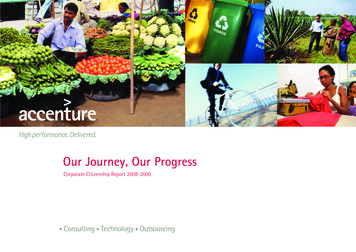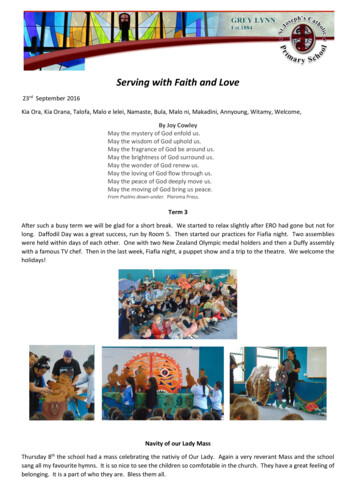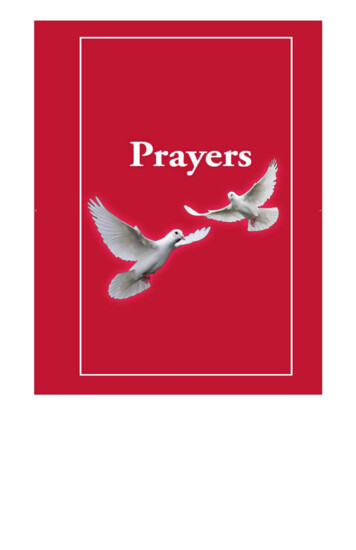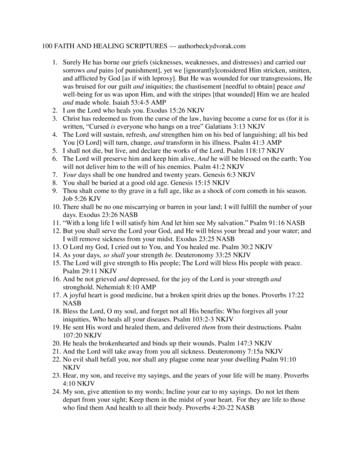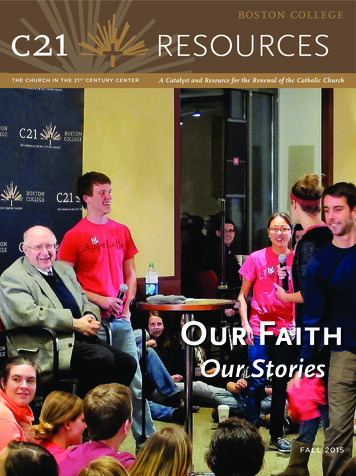
Transcription
T H E C H U R C H I N T H E 2 1 S T C E N T U RY C E N T E RA Catalyst and Resource for the Renewal of the Catholic ChurchOur FaithOur StoriesFALL 201 5
“on the coverFr. Michael Himes shares a personal faith story abouthis family at the popular monthly speaker series forstudents, Agape Latte.Human beings are called to bethe people who do what God is.God is agape and we get to enactit. That is the most extraordinarystatement about being a humanbeing that I know.”— Fr. Michael Himes, Agape Latte, November 2014The Church in the 21st Century Centeris a catalyst and resource for the renewalof the Catholic Church.C21 Resources, a compilation of critical analyses and essayson key challenges facing the Church today, is published bythe Church in the 21st Century Center at Boston College, inpartnership with featured authors and publications.c21 resources editorial boardJonas BarciauskasBen BirnbaumPatricia DelaneyThomas GroomeRobert NewtonBarbara RadtkeJacqueline Reganguest editorBrian Bramanmanaging editorKaren K. Kieferassistant editorConor Kellyphoto editorElizandra Zapatathe church in the 21st century centerboston college110 college roadchestnut hill, massachusetts 02467www.bc.edu/c21church21@bc.eduPrint and Digital production byProgressive PrintContents2God Moves in Us through Stories6The Story Power of Agape Latte7Forgive and Let Live8A Promise to a Friendby Brian Bramanby Karen Kieferby Steve Popeby Jack Dunn10The Story of My Vocation12Share Your Faith Storiesby Pope Francisby Thomas Groome14Stories that Explain and a Messagethat Transformsby N.T. Wright16Christ Is Our Story18Clearing God’s Name19Stay Open20The Catholic Imagination through Storyby John Navone, S.J.by Nathan Englanderby Marina McCoyby Andrew Greeley 2015 Trustees of Boston College
God Loves StoriesGuest Editor C21 Resources Fall 2015BRIAN BRAMAN is the guest editor of this issue of C21Resources. He is a professor in the philosophy departmentat Boston College and director of the Perspectives Program,a four-year interdisciplinary program of the humanities andnatural sciences. Braman is also on the faculty of the Collegeof Advancing Studies. His areas of interest are the intersectionof philosophy and art, and the work of Bernard Lonergan, S.J.21Storytelling and the SacramentalImaginationby Alice McDermott22God Can Work in Strange Ways23Born on Third Base24Becoming a Somebody2526C21 Fall Events28Stories That Matter: Faith And Film30You Are Made Worthy32Strings of Faith34Morality and Stories36God Worksby Mary Troxellby William B. Neenan, S.J.by Roberto GoizuetaReading Into Faithby Nichole Devaneyby Thomas Hibbsby Theresa O’Keefeby Katherine PierDO YOU EVER wonder why stories are so engaging? Onemight attempt an explanation from the cognitive sciencesor offer an analysis from literary criticism of the power ofnarratives. However, there is an old Chasidic tale that Godmade humankind because God loves stories (read it onpage 13). With our being made in the divine image (Genesis1:26), little wonder that we love stories, too. Indeed, theBible requires us to tell stories, of faith both to God and toone another.That we tell God the story is encouraged repeatedly. Whenoffering “the first fruits of the land” in worship, Mosesinstructs the Israelites to tell God their story as God’s ownpeople, beginning with the call of Abraham down to God’sliberating them from slavery in Egypt (see Deuteronomy 26:111). And what else is the celebration of the Eucharist but areminding of God and ourselves of the story of Jesus’ LastSupper, and his redeeming self-gift on our behalf happensagain—from retelling the story.The Bible makes clear, too, that God’s people need toremember their story for their own faithfulness. A repeatedmandate throughout the Old Testament is “Do not forget.”As the Haggadah instructs, when the youngest child asks atPassover, “Why is this night different from all other nights?”the adult response is to tell the story of their slavery andliberation by God.Of course, the exemplar of storyteller par excellence inChristian faith is that Carpenter from Nazareth, and mostobviously in his parables. We Christians have been tellingthe story of Jesus and the stories that he told ever since—allamounting to “the greatest Story ever told.”This issue of C21 Resources reflects the continuing power ofstories to both nurture and share our faith. In our postmodernworld, there may still be nothing more effective for faithformation than to recall and tell our stories of God’s savingwork in human history, including our own. I thank our editor ofthis edition, Professor Brian Braman, his assistant Conor Kelly,and our managing editor, Karen Kiefer.by Russell B. Connors Jr. andPatrick T. McCormickby William P. Leahy, S.J.Tom GroomeDirectorfal l 2015 c 21 resources1
GodMovesin UsthroughStoriesBrian BramanSt. Ignatius of Loyola2c 2 1 r e sour ce s fa l l 20 1 5
IN 1913 a brilliant young student transferred to Gottingen University to study under the guidance of EdmundHusserl, “father of Phenomenology.” She became his pupiland teaching assistant, and later Husserl advised her onher doctoral thesis. It was during this period of intellectual work with Husserl that her search for the “one thingneedful” intensified. She had drifted away from the faithof her childhood and longed to be at home in a faithcommunity. One night, when at some friends’ home, shehappened to pick up St. Theresa of Avila’s autobiography.She became so captivated with this book that she stayed upall night and read it in its entirety. After finishing the bookshe is reported to have said: “This is truth.” She convertedto Catholicism shortly thereafter: her name, St. Edith Stein.In 1521 a young Spanish nobleman was wounded in abattle against French forces. One of his legs was shatteredand upon being captured he was sent back to his home torecuperate. This young man grew up reading romantictales of courtly love, knights rescuing damsels in distress,and knightly deeds of great valor. Unfortunately, as he layconvalescing from his wound, he had none of his belovedromantic novels to read. In fact, the only two books hehad available to him were the Life of Christ and The Lives ofthe Saints. It was reading these stories about the saints andChrist’s life that began to fire his imagination in such a way(summer), comedic (spring), satiric/ironic (fall), and tragic(winter). All of these plots in one way or another expressour deepest longings, desires, and fears. Romantic plotsentail a sense of adventure. Heroes and heroines embarkupon a journey to test their characters. They encounter eviland harm, but they ultimately triumph over adversity. It isnearest of all literary forms to the wish-fulfillment dream.Tragedy, on the other hand, explores the limits of our powerand desire to make our wishes and dreams come true. Thecentral theme of a tragic plot is that catastrophe and deathcan befall a heroic character at any moment. Tragedy isan imaginative attempt to balance our potential greatnesswith our perishable nature. From tragedy we move to irony.Irony is a story of middle age. It is a parody of a romanceplot; the hero is all too human; he or she is subject to the illsof the world; his or her quests remain unfulfilled, or they arewrongheaded or aimless and senseless; he or she just growsold and dies. Irony reflects the permanent discrepancybetween what is and what ought to be. Finally, there iscomedy. The comic vision reconciles as many charactersas possible in the reconstitution of society. The comicvision embraces the limitations and follies of the world ofexperience but asserts faith in more powerful images ofreconciliation, renewal, or rebirth. The story of Christ isthe quintessential comedic plot.Stories shape who we are, where we come from,how we understand ourselves.that he thought of himself as wanting to be a hero and aknight for Christ; he now wanted to do great deeds such asthe saints had done, but in the context of the rediscoveryof his Catholic faith: that young man as we all know wasSt. Ignatius of Loyola.The point to these examples is to suggest that beforeanything else we are the type of beings who tells stories,listens to stories, and reads stories. We are storytellers.Stories shape who we are, where we come from, how weunderstand ourselves. There are stories of origins, storiesof destiny, and stories of faith. Stories are the life-bloodof culture and faith. Stories articulate the fundamentalmeanings and values of a culture, of a faith life. Think ofthe story of George Washington crossing the Delaware, thestory of “the shot heard round the world,” the story of “thedeath and resurrection of Jesus.”So what type of stories do we tell? Northrop Frye hasargued in his work Anatomy of Criticism there are fourfoundational plots, that is, stories, to all literature and theseplots are associated with the seasons of our life: romanticThese plots form an entire cycle of life from birth toeventual death. Thus, to go beyond the youth (summer)of romance requires the ability to imagine the possibilitythat wishes and dreams can end in catastrophe and death(tragedy); to move from tragedy to irony/satire (fall) requiresthat one confronts the fact there is a permanent discrepancybetween one’s dreams and the ambiguous reality of whatactually is. The movement out of winter into spring, then,requires the transformation of this limited world into a newcommunity freed from the power of death and sin to undoit (comedy).When we think of how stories can shape our faith, weshould be aware that our faith journey, and even our prayerlife, is analogous to this plot cycle of life. Our faith is at onceromantic, tragic, ironic, and comedic. The stories we readoften reflect where we are on our own spiritual journey.When we think of stories and faith we automaticallyresonate with biblical stories; stories of the saints, or storiesof someone’s faith journey. For example, Graham Greene’sThe Power and the Glory, or Shusaku Endo’s The Samurai,fal l 2015 c 21 resources3
or Silence. All great literature either implicitly or explicitlytouches upon the search for God.In addition to those cycle of stories that reveal ourdeepest longings, desires, failures, and triumphs, we havestories from holy men and women about their own quest forGod. I imagine if you were asked by a friend to recommenda good book for spiritual reading you might suggest Theresaof Lisieux’s Story of a Soul, or Julian of Norwich’s Reflectionsof Divine Love, or the poetry of John of the Cross. Yet if Iwere to say to you, “How about reading Carl Boyer’s TheHistory of the Calculus, my guess is you would think me mildlydemented. What on earth could a book on mathematics,particularly the history of calculus, do for my faith life, myspiritual life? Perhaps more than you can imagine.Whenever we think of stories, or more specificallythose associated with stories of faith, we usually think ofthe traditional narratives, or traditional forms of spiritualstories. Yet I always tell my students that the search forGod is not unique to literature or poetry. There is music.For example Mahler’s Resurrection Symphony or JohnColtrane’s jazz classic Love Supreme, a musical story of hisreligious conversion. There is architecture. Think of thegothic architecture of Boston College. It tells a story. It isa story that puts us in the Middle Ages, the story of faithand reason; more importantly, these buildings continueto tell the story of our own intellectual struggles, or ourcollective journey of faith. Painting is another vital way totell stories of one’s faith, or its absence. There is the icontradition coming out of the Eastern Church. There are4c 2 1 r e sour ce s fa l l 20 1 5the great artists of the Middle Ages and beyond: Giotto,Caravaggio, Titian, or the post-impressionist Gauguinand his powerful masterpiece: Who Are We? What Are We?Where Are We Going? We also find stories of despair and theloss of faith. Think of Edvard Munch and his depiction ofpsychological suffering. Or the German expressionist ErnstLudwig Kirchner who like Munch was gripped by the fearsand anxieties concerning man’s place in the modern world,and the loss of a genuine sense of spirituality and faith.Sometimes photographs themselves tell powerful stories.Meditate on the photograph of Pope Francis washing thefeet of prisoners. The story that this simple photo tells isthe Gospel of Matthew: “Truly I say to you, to the extentthat you did it to one of these brothers of Mine, even theleast of them, you did it to Me.” There are innumerablemethods of telling stories about one’s struggle and journeyin faith; stories that can lead to light and life, or stories thatreveal to us what a world or an individual life absent of Godwould mean.Up to this point, I have written broadly about the natureof stories; the different kinds of stories, and the differentways that stories can be told. Yet there is another kind ofstory, and it is nontraditional. The story that I want totell makes sense of why one might read Boyer’s book onThe History of the Calculus for spiritual reading. This storybegins with St. Augustine. Augustine tells us that whatmakes us most like God is the fact that we are the createdparticipation in the uncreated light. It is our intelligencethat makes us most like God. When we think of stories
Paul Gauguin, 1848–1903. Where Do WeCome From? What Are We? Where Are WeGoing?, 1897–98about our Christian faith we often fail to advert to the waythat God’s self-story is being communicated through ourintellectual tradition. The Ignatian maxim of finding Godin all things seems to include almost everything except theintellectual life.I want to suggest that to immerse oneself in theintellectual story of Western culture is to expand theCatholic imagination in such a way that you open yourselfup in a richer and deeper way to the experience of beingloved by the Triune God. Think of our Western culturalstory as a story about the relationship between faith andreason, or simply put, a love story between God and hiscreation. It is a tumultuous love story, but nonetheless astory. It is a story that is all at once romantic, ironic/satiric,tragic, and comedic, and to a large degree a story that hasbeen forgotten or lost.To remember and reappropriate this cultural story is tobe educated in wisdom. Being educated in wisdom meansunderstanding how our intelligence can be the foundationfor an ordered love of God, of self, and of neighbor. Anotherway to think about this education in wisdom is to imaginehow reading great books can help one fall in love with theTriune God. Falling in love with God opens us up to thewonders of the entire universe; the wonders of anotherhuman being, to the giftedness of the life that has beengiven to us, and to recognize the beauty of the world inwhich our lives unfold. It is in a true liberal arts educationthat we can encounter the mystery of God’s self-story.For example, there is something profoundly beautiful andeven holy about Newton’s new world order, or Einstein’sgeneral and special relativity theories. Think of the wonderand awe that can come from reading Darwin’s Origin of theSpecies and reflect on God’s infinite creative imagination,and how this dynamic and evolutionary universe is God’sself-story. Galileo tells us that God is a geometer, the natureof the universe is written in the story of mathematics. Howwondrous was the invention of the calculus. These are allstories about the human intellect’s created participation inthe uncreated light. A number of years ago, I heard aninterview with a math professor at Rochester Instituteof Technology. Her work was in multiple dimensionalgeometries. The interviewer asked her why she did this kindof work since it seemed to have no real-world applications;her response, “I do this because it is beautiful.” As aChristian, I am firmly convinced that her work is telling astory of God’s own mysterious beauty.Let me end my story by rewording a comment from myfriend and mentor Fred Lawrence here in our theologydepartment:“The intellectual life in the context of friendshipwith God underscores the fundamental pointthat God’s self-communicating story is a storyof Trinitarian love. This story is constitutive ofwho and what we are; it makes us to be personsin a communal story of faith. This intellectualfriendship is not only a story of our faith life,but also a story of the cosmos as it struggles tobecome what God desires. The story that weare personally, communally, and historically is astory that is part of the unfolding of the divinestorytelling in human history most profoundly toldin the revelation of the Eternal Word made flesh.”Finally, what we have in this issue of C21 Resources is a richseries of essays and articles that introduce us to the power,strength, and diversity of storytelling and its relationship tofaith formation. From Karen Kiefer’s “The Story Power ofAgape Latte” and its stories, to Andrew Greeley, and AliceMcDermott and the power of the Catholic sacramentalimagination, to the ‘Stories that Matter: Faith and Film,” tostories of Latino/a spirituality, and theological accounts ofstorytelling and faith, each essay is designed to enlarge ourCatholic imagination and help us become more sensitive tothe way that God moves in us through stories. BRIAN BRAMAN is the guest editor of this issue of C21 Resources.photo credits: Page 2: Artwork by Sue Kouma Johnson.www.suekoumajohnson.comPages 4–5: Photograph 2015 Museum of Fine Arts, BostonWatch Brian Braman’s Agape Latte talk, “Intellectual Life andFriendship with God.” Visit: www.bc.edu/c21storiesfal l 2015 c 21 resources5
The StoryPower ofAgape LatteKaren KieferOUR FAITH STORIES matter. They remind uswho we are and where we’ve been and help us see all thatis possible through God’s amazing grace. Although it canbe scary and challenging, sharing our personal stories withothers connects us to others in a more intimate way and canbecome a catalyst for powerful conversations. No questionit is these kinds of conversations that transform and changeperspectives, change directions, change lives.That has certainly been the case with cleverly namedmonthly speaker series Agape Latte, launched at BostonCollege back in 2006 through a partnership with theChurch in the 21st Century Center and Campus Ministry.The name “Agape Latte” is derived from the Greek word“agape” which is defined as the unconditional love of Godand, of course, “latte” being the popular coffee drink.Bringing together storytellers, God, and lattes in acoffee bar setting seemed like a perfect programmingbrew. By reflecting on someone’s personal faith story,Agape Latte had the potential to help students broachtender conversations about their own deepest desires,challenges, happiness and relationships. Add to the brewan overflowing dessert buffet, coffee and music and themodel had some staying power.Like most big ideas, the program started small. Fifty or sostudents would gather each month on a Tuesday evening tohear well-known figures at Boston College—everyone fromthe president of Boston College to professors and coaches —tell stories about transformative moments in their liveswhere they saw God working. Their stories were powerfulenough to uproot the comfort of a smartphone and get6c 2 1 r e sour ce s fa l l 20 1 5students talking and showing up. Fifty students has grownto 500 at some Agape Lattes, and the success story continues.What makes Agape Latte work? The stories and thestudents.The program is student-run and student-driven. Membersof the C21 Center’s Student Board invite the speakers, coachthe speakers, plan and market the event, and bring AgapeLatte to life on campus. Students understand best whatstudents want: an authentic story that relates to their journey.For many, these stories reveal what faith can deliver, whilethe conversations that characterize an Agape Latte make a“God talk” more comfortable and, yes, possible.Due to the popularity
boston college 110 college road chestnut hill, massachusetts 02467 . Bible requires us to tell stories, of faith both to God and to . and knightly deeds of great valor. Unfortunately, as he lay convalescing from his wound, he had none of his belove




